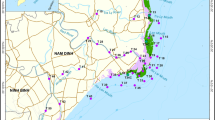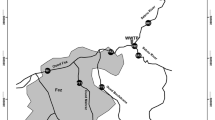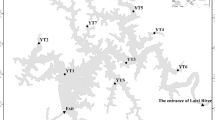Abstract
Heavy metal accumulation and potential releases from loose deposits in drinking water distribution system (DWDS) can have critical impacts on drinking water safety, but the associated risks have not been sufficiently evaluated. In this work, the potential biological toxicity of heavy metals in loose deposits was calculated based on consensus-based sediment quality guidelines, and the effects of some of the main water quality parameters, such as the pH and bicarbonate and phosphate content, on the release behaviors of pre-accumulated heavy metals were investigated. The results showed that heavy metals (Cu, As, Cr, Pb, and Cd) significantly accumulated in all the samples, but the contents of the heavy metals were multiple magnitudes lower than the Fe and Mn contents. The potential biotoxicity of As and Cu was relatively high, but the biotoxicity of Cd was negligible. The water quality can significantly influence the release of heavy metals from loose deposits. As the pH increased from 7.0 to 9.0, the release of As and Cr obviously increased. The release of As, Cu, Pb, and Cr also accelerated with the addition of phosphate (from 1 to 5 mg/L). In contrast to the trends for the pH and phosphate, variations in the bicarbonate content did not have a significant influence on the release of As and Cr. The release ratios of heavy metals in the samples were very low, and there was not a correlation between the release rate of the heavy metals in the loose deposits and their potential biotoxicity.








Similar content being viewed by others
Explore related subjects
Discover the latest articles and news from researchers in related subjects, suggested using machine learning.References
Antelo, J., Avena, M., Fiol, S., López, R., & Arce, F. (2005). Effects of pH and ionic strength on the adsorption of phosphate and arsenate at the goethite-water interface. Journal of Colloid and Interface Science, 285(2), 476–486.
Benson, A. S., Dietrich, A. M., & Gallagher, D. L. (2012). Evaluation of iron release models for water distribution systems. Critical Reviews in Environmental Science and Technology, 42(1), 44–97.
Carrière, A., Gauthier, V., Desjardins, R., & Barbeau, B. (2005). Evaluation of loose deposits in distribution systems through unidirectional flushing. Journal/American Water Works Association, 97(9), 82-92.
Cerrato, J. M., Reyes, L. P., Alvarado, C. N., & Dietrich, A. M. (2006). Effect of PVC and iron materials on Mn(II) deposition in drinking water distribution systems. Water Research, 40(14), 2720–2726.
Copeland, R. C., Lytle, D. A., & Dionysious, D. D. (2007). Desorption of arsenic from drinking water distribution system solids. Environmental Monitoring and Assessment, 127(1–3), 523–535.
Gerke, T. L., Little, B. J., & Barry Maynard, J. (2016). Manganese deposition in drinking water distribution systems. Science of the Total Environment, 541, 184–193.
Gheju, M., Balcu, I., & Mosoarca, G. (2016). Removal of Cr(VI) from aqueous solutions by adsorption on MnO2. Journal of Hazardous Materials, 310, 270–277.
Hsu, J.-C., Lin, C.-J., Liao, C.-H., & Chen, S.-T. (2008). Evaluation of the multiple-ion competition in the adsorption of As(V) onto reclaimed iron-oxide coated sands by fractional factorial design. Chemosphere, 72(7), 1049–1055.
Jain, A., & Loeppert, R. H. (2000). Effect of competing anions on the adsorption of arsenate and arsenite by ferrihydrite. Journal of Environment Quality, 29(5), 1422.
Li, M., Liu, Z., Chen, Y., & Hai, Y. (2016). Characteristics of iron corrosion scales and water quality variations in drinking water distribution systems of different pipe materials. Water Research, 106, 593–603.
Liu, J., Yin, P., Chen, B., Gao, F., Song, H., & Li, M. (2016). Distribution and contamination assessment of heavy metals in surface sediments of the Luanhe River Estuary, northwest of the Bohai Sea. Marine Pollution Bulletin, 109(1), 633–639.
Liu, G., Zhang, Y., Knibbe, W. J., Feng, C., Liu, W., Medema, G., & van der Meer, W. (2017). Potential impacts of changing supply-water quality on drinking water distribution: a review. Water Research, 116, 135-148.
Lytle, D. A., Sorg, T. J., & Frietch, C. (2004). Accumulation of arsenic in drinking water distribution systems. Environmental Science and Technology, 38(20), 5365–5372.
Lytle, D. A., Sorg, T. J., Christy, M., & Lili, W. (2010). Particulate arsenic release in a drinking water distribution system. Journal/American Water Works Association, 102(3), 87–98.
MacDonald, D. D., & Ingersoll, C. G. (2010). Tools for assessing contaminated sediments in freshwater, estuarine, and marine ecosystems. Sedimentology of Aqueous Systems, 171–199. https://doi.org/10.1002/9781444317114.ch7.
MacDonald, D., Ingersoll, C., & Berger, T. A. (2000). Development and evaluation of consensus-based sediment quality guidelines for freshwater ecosystems. Archives of Environmental Contamination and Toxicology, 39(2000), 20–31.
McNeill, L. S., & Edwards, M. (2001). Review of iron pipe corrosion in drinking water distribution systems. Journal AWWA, 93(7), 88–100.
Morillo, D., Pérez, G., & Valiente, M. (2015). Efficient arsenic(V) and arsenic(III) removal from acidic solutions with novel forager sponge-loaded superparamagnetic iron oxide nanoparticles. Journal of Colloid and Interface Science, 453, 132–141.
Nawrocki, J., Raczyk-Stanisławiak, U., Świetlik, J., Olejnik, A., & Sroka, M. J. (2010). Corrosion in a distribution system: Steady water and its composition. Water Research, 44(6), 1863–1872.
Oliveira, A., Palma, C., & Valença, M. (2011). Heavy metal distribution in surface sediments from the continental shelf adjacent to Nazaré canyon. Deep Sea Research Part II: Topical Studies in Oceanography, 58(23), 2420–2432.
Peña-Icart, M., Mendiguchía, C., Villanueva-Tagle, M., Bolaños-Alvarez, Y., Alonso-Hernandez, C., Moreno, C., & Pomares-Alfonso, M. S. (2017). Assessment of sediment pollution by metals. A case study from Cienfuegos Bay, Cuba. Marine Pollution Bulletin, 115(1–2), 534–538.
Peng, C.-Y., & Korshin, G. V. (2011). Speciation of trace inorganic contaminants in corrosion scales and deposits formed in drinking water distribution systems. Water Research, 45(17), 5553–5563.
Peng, C. Y., Korshin, G. V., Valentine, R. L., Hill, A. S., Friedman, M. J., & Reiber, S. H. (2010). Characterization of elemental and structural composition of corrosion scales and deposits formed in drinking water distribution systems. Water Research, 44(15), 4570–4580.
Peng, C. Y., Hill, A. S., Friedman, M. J., Valentine, R. L., Larson, G. S., Romero, A. M. Y., et al. (2012). Occurrence of trace inorganic contaminants in drinking water distribution systems. Journal - American Water Works Association, 104(3), 53–54.
Sarin, P., Snoeyink, V. L., Bebee, J., Kriven, W. M., & Clement, J. A. (2001). Physico-chemical characteristics of corrosion scales in old iron pipes. Water Research, 35(12), 2961–2969.
Sarin, P., Snoeyink, V. L., Bebee, J., Jim, K. K., Beckett, M. A., Kriven, W. M., & Clement, J. A. (2004). Iron release from corroded iron pipes in drinking water distribution systems: Effect of dissolved oxygen. Water Research, 38(5), 1259–1269.
Serafim, A., Company, R., Lopes, B., Pereira, C., Cravo, A., Fonseca, V. F., França, S., Bebianno, M. J., & Cabral, H. N. (2013). Evaluation of sediment toxicity in different Portuguese estuaries: ecological impact of metals and polycyclic aromatic hydrocarbons. Estuarine, Coastal and Shelf Science, 130, 30–41.
Silva, J., De Mello, J. W. V., Gasparon, M., & Abrahão, W. A. P. (2012). Effects of competing anions and iron bioreduction on arsenic desorption. Water, Air, and Soil Pollution, 223(9), 5707–5717.
Smedley, P., & Kinniburgh, D. (2002). A review of the source, behaviour and distribution of arsenic in natural waters. Applied Geochemistry, 17(5), 517–568.
Stachowicz, M., Hiemstra, T., & Van Riemsdijk, W. H. (2007). Arsenic-bicarbonate interaction on goethite particles. Environmental Science and Technology, 41(16), 5620–5625.
Sun, H., Shi, B., Lytle, D. A., Bai, Y., & Wang, D. (2014). Formation and release behavior of iron corrosion products under the influence of bacterial communities in a simulated water distribution system. Environmental Science: Processes & Impacts, 16(3), 576–585.
Sun, H., Shi, B., Yang, F., & Wang, D. (2017). Effects of sulfate on heavy metal release from iron corrosion scales in drinking water distribution system. Water Research, 114, 69–77.
Turgut, C., Katie Pepe, M., & Cutright, T. J. (2005). The effect of EDTA on Helianthus annuus uptake, selectivity, and translocation of heavy metals when grown in Ohio, New Mexico and Colombia soils. Chemosphere, 58(8), 1087–1095.
Veschetti, E., Achene, L., Ferretti, E., Lucentini, L., Citti, G., & Ottaviani, M. (2010). Migration of trace metals in Italian drinking waters from distribution networks. Toxicological and Environmental Chemistry, 92(3), 521–535.
Xie, Y., & Giammar, D. E. (2011). Effects of flow and water chemistry on lead release rates from pipe scales. Water Research, 45(19), 6525–6534.
Yang, F., Shi, B., Gu, J., Wang, D., & Yang, M. (2012). Morphological and physicochemical characteristics of iron corrosion scales formed under different water source histories in a drinking water distribution system. Water Research, 46(16), 5423–5433.
Yang, F., Shi, B., Bai, Y., Sun, H., Lytle, D. A., & Wang, D. (2014). Effect of sulfate on the transformation of corrosion scale composition and bacterial community in cast iron water distribution pipes. Water Research, 59, 46–57.
Funding
This work was supported by the National Natural Science Foundation of China (51678558, 51378493) and the National Key R&D Program of China (2016YFC0400803).
Author information
Authors and Affiliations
Corresponding author
Rights and permissions
About this article
Cite this article
Liu, Q., Han, W., Han, B. et al. Assessment of heavy metals in loose deposits in drinking water distribution system. Environ Monit Assess 190, 388 (2018). https://doi.org/10.1007/s10661-018-6761-9
Received:
Accepted:
Published:
DOI: https://doi.org/10.1007/s10661-018-6761-9




